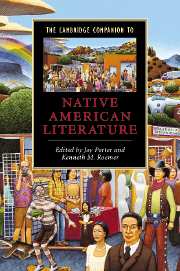Book contents
- Frontmatter
- Introduction
- Timeline
- Part I Historical and cultural contexts
- Part II Genre contexts
- 4 Non-fiction prose
- 5 Native American life writing
- 6 America’s indigenous poetry
- 7 Pre-1968 fiction
- 8 Fiction
- 9 American Indian theatre
- Part III Individual authors
- Bio-bibliographies
- Further reading
- Index
- Series List
9 - American Indian theatre
from Part II - Genre contexts
Published online by Cambridge University Press: 28 May 2006
- Frontmatter
- Introduction
- Timeline
- Part I Historical and cultural contexts
- Part II Genre contexts
- 4 Non-fiction prose
- 5 Native American life writing
- 6 America’s indigenous poetry
- 7 Pre-1968 fiction
- 8 Fiction
- 9 American Indian theatre
- Part III Individual authors
- Bio-bibliographies
- Further reading
- Index
- Series List
Summary
Like the Native American Literary Renaissance, the Native Theatre Movement is a relatively recent phenomenon. With the formation of several Native American theatre companies in the 1970s, many Native playwrights began finding audiences for their work, yet publications of their plays or scholarship on Native theatre was rare. In the first years of the twenty-first century, while more published plays are available, Native theatre productions in the US are still limited in number, a point of frustration for playwrights, actors, and other artists. This chapter provides an overview of the Native Theatre Movement both in print and on the stage and notes in particular some of the challenges and difficulties that Native theatre artists face and overcome. Because the film industry has parallel issues, the article also references - though sparingly - recent developments in film.
The Native Theatre Movement
Native people were by no means new to the performing arts in the late twentieth century. One of the more successful playwrights of the 1930s, in fact, was Cherokee. Born in Indian Territory in 1899, Lynn Riggs wrote over twenty-five plays, and most of them were published during his lifetime. He is best known now for his play Green Grow the Lilacs (1929/1931), which was adapted by Richard Rodgers and Oscar Hammerstein II to become Oklahoma! While writing Green Grow the Lilacs, Riggs wrote to a friend that he had an idea for a new American play, “one I have contemplated for some time, a dramatic study of the descendants of the Cherokee Indians in Oklahoma, to be called The Cherokee Night.” Cherokee Night (1930/1932) would be Riggs’s only play with Indian themes. His writing had not been included often in discussions about Native literature until Jace Weaver offered a new reading of three of Riggs’s plays in That the People Might Live: Native American Literatures and Native American Community (1997).
- Type
- Chapter
- Information
- The Cambridge Companion to Native American Literature , pp. 189 - 204Publisher: Cambridge University PressPrint publication year: 2005
- 4
- Cited by



